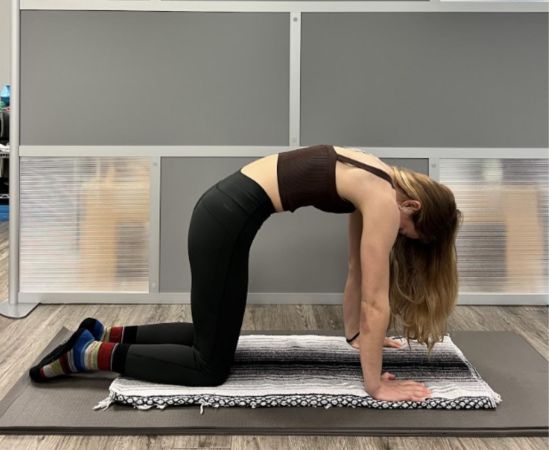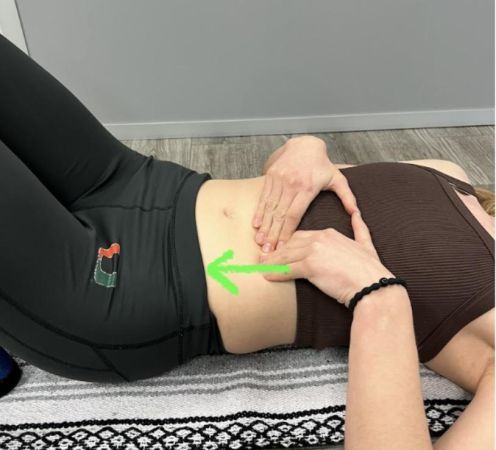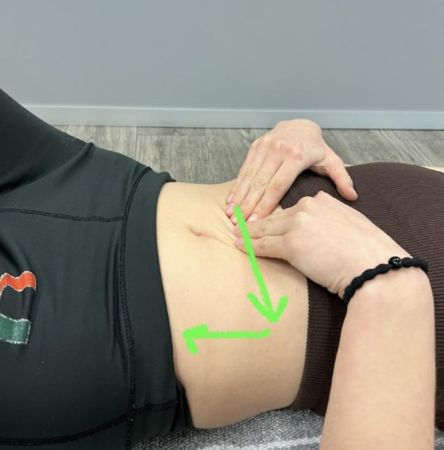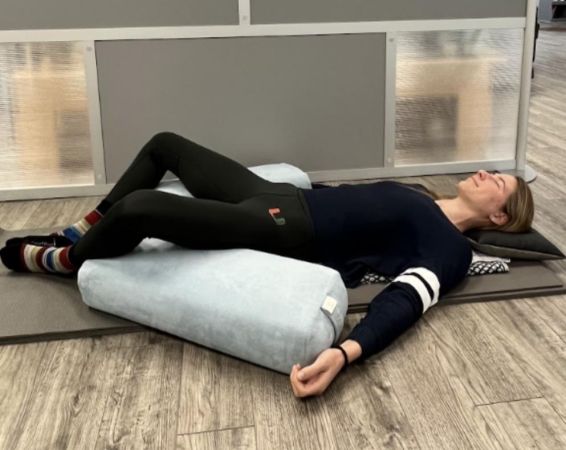
March is Endometriosis Awareness Month.
Today, we explore different exercises someone can do at home to relieve endometriosis pain.
For more information on endometriosis, see our article HERE.
Before we begin exploring gentle movements to relieve endometriosis pain, we will cover how someone may identify the pain they are having could be endometriosis. The unfortunate truth is that endometriosis can only be confirmed through laparoscopic surgery. Most people go years without getting a diagnosis or proper treatment. One study found that the average delay of diagnosis is 8.5 years!1 This is for many reasons, including the lack of awareness of the condition, the many bodily systems it involves that complicates the clinical picture, and the absence of noninvasive diagnostic testing to detect endometriosis. Through this, doctors are able to identify the endometrial-like tissue (tissue that is similar to, but not the same as, the lining of the uterus) that can be found throughout the body.
Oftentimes, the GI system is involved, and many are sent on what they would describe as a wild goose chase as they are referred from specialist to specialist, but never receiving meaningful care due to the proper diagnosis being missed. This is why at Femina Physical Therapy, we spend this month shouting from the rooftops in hopes that just even just 1 person can feel heard, and gain some clarity about either their own issues, or for someone they know.
Below are common symptoms of endometriosis to know if this diagnosis should be on your radar, and so our readers are better equipped at differentiating pains they may be having.
- Abdominal Pain
- Pelvic pain
- Painful periods
- Excessive menstrual bleeding
- Urinary frequency, urgency, or painful urination
- Diarrhea, constipation, nausea, painful bowel movements, abdominal bloating
- Painful periods (dysmenorrhea)
- Pain with penetrative intercourse (dyspareunia)
- GI issues – pain with bowel movements (dyschezia), diarrhea, constipation, abdominal bloating, nausea)
- Painful bladder or urinary urgency and frequency (sometimes referred to as Interstitial Cystitis)
- Vulvar pain (vulvodynia or vestibulodynia)
- Low back or sciatic pain and other orthopedic issues, including jaw pain (TMJ dysfunction)
- Pain that radiates down the legs
- Missing school or work due to pain, nausea and/or vomitting
- Infertility or other fertility challenges
- Fatigue
- Brain fog
Now, if pain is one of your symptoms…let’s get to some RELIEF!
Exercises to Relieve Endometriosis Pain


Exercise #1: Cat-Cow
- Begin on hands and knees with your hands under your shoulders and knees under your hips.
- Inhale through your nose and arch your back while you look upward. Expand your belly with the breath and stretch the muscles of the abdomen with the arching spinal movement.
- Exhale through your mouth as you start to round your spine, tucking your tailbone and chin while using your abs to further exhale.
- Repeat 2×10 (inhale+exhale = 1)
- This movement may relieve endometriosis pain through inviting elongation and stretch to the abdominal muscles that may be experiencing pain and reflexive guarding in response to pain. The spinal movement mobilizes the cervical, thoracic, and lumbar vertebral segments, while offering a gentle massage to the abdominal organs and surrounding viscera as you expand and compress the torso.
- Only move through as much range of motion that creates a gentle tug, not a strong pull, on the abdomen.


“I” “L” “U”
Exercise #2: ILU Abdominal Massage
Endometriosis can influence the natural function of the GI tract. The “ILU” massage helps stimulate gut motility to encourage the passage of stool and relieve blockages. Secondly, under the lens of gate control theory, this can help minimize the intensity of abdominal pain by blocking pain fibers with stimulation to thicker sensory nerve fibers.
- Start on the upper left belly, making gentle circular motions alternating with long strokes down towards your left hip. Do this 8-10x. This makes the “I” motion.
- Then place your hands on your upper right abdomen, and work from right to left for 8-10x circles and strokes, continuing the motion down towards your left hip. This makes the “L” motion.
- Lastly, move directly up from the lower right belly towards your rib cage, move across from right to left as above, then down towards your left hip, making scooping motions toward the middle of your abdomen. This makes the “U” motion. This encourages stool to transfer from your colon to the rectum.

Exercise #3: Reclined Bound Angle
Lie on your back with pillows that support your upper back and your head. Bend your knees and open up at the hips like a frog with pillows to support your legs.
How does this pose help relieve endometriosis pain?
This pose invites length and relaxation to your inner thigh, or adductor muscle group. This muscle group shares myofascial connection to the pelvic floor through virtue of where this muscle group originates from. The adductor group is commonly recruited as a compensatory strategy to make up for pelvic floor weakness. This can be conceptualized by when someone is trying to hold in pee before they reach a restroom – they cross their legs! Diaphragmatic breathing while holding this inner thigh stretch enhances pelvic floor muscle relaxation.
Exercise #4: Diaphragmatic Breathing
Put your hands on your ribcage and inhale through your nose, expanding your rib cage and belly 360 degrees, and exhaling slowly through pursed lips.
The breathing mechanics that should be incorporated into the above exercises is essential. This targets the autonomic nervous system, or the fight or flight and rest and digest. Controlled and intentional breathing modulates the nervous system to activate the parasympathetic arm, or rest and digest state.
How does this pose help relieve endometriosis pain?
Chronic pain and inflammation is commonly seen in individuals with endometriosis. Chronic pain enhances the sympathetic, fight or flight nervous system which sensitizes our experience of pain. Additionally, the diaphragm’s descent on inhalation creates a pistoning movement in unison with the pelvic floor, so there is a gentle lengthening and downward bulge of these muscles. Endometriosis is associated with pelvic floor hypertonicity, meaning that pelvic floor muscles are shortened and overactive which may lead to further pelvic pain.
This focused breathing is the most straightforward, but the most difficult to sit and have patience with. Although the benefits are not as easily seen as a muscle stretch, the internal neural environment will sway in favor of a more regulated state. There is a lot going on while you allow yourself to have nothing going on!
Exercise #5: Walking Aerobic Exercises
Aerobic exercise increases our circulating endorphines, which are our natural pain relievers and feel-good transmitters.
How can this help relieve endometriosis pain?
Walking for 30 mins a day touches on a few bodily systems. Walking gives a dose of cardiovascular exercise to the heart, as many people know. Walking can also help with digestion. Endometriosis may influence the normal function of the gastrointestinal system if adhesions are located on or near these important structures. Walking is an additive exercise to enhance digestion through stimulating the digestive system, and promoting the passage of food as to avoid bloating and abdominal pains. Walking may also aid in the control of blood sugar spikes.1 Since endometriosis is a chronic inflammatory disease, controlling for this may also offer systemic benefits overtime and protect against type-2 diabetes.2 Lastly, if it is a sunny day out, getting sunlight for 15 minutes increases endogenous vitamin D, serotonin and dopamine.3
May this post serve as a general guideline for safe and gentle movements to help relieve discomfort. Every human body is different, and everyone enjoys exercise differently based on their interests or physical capabilities. Individuals who are experiencing symptoms caused by endometriosis can benefit from pelvic floor physical therapy.4 For a prescribed exercise program based on your clinical picture, and your personal goals, see a licensed pelvic floor physical therapist.
Find us at one of our Los Angeles locations here: https://feminapt.com/contact-us
References:
- Ballard K, Lowton K, Wright J. What’s the delay? A qualitative study of women’s experiences of reaching a diagnosis of endometriosis. Fertil Steril. 2006 Nov;86(5):1296-301. doi: 10.1016/j.fertnstert.2006.04.054. PMID: 17070183.
- Hijikata Y, Yamada S. Walking just after a meal seems to be more effective for weight loss than waiting for one hour to walk after a meal. Int J Gen Med. 2011;4:447-50. doi: 10.2147/IJGM.S18837. Epub 2011 Jun 9. PMID: 21731896; PMCID: PMC3119587.
- Mead MN. Benefits of sunlight: a bright spot for human health. Environ Health Perspect. 2008 Apr;116(4):A160-7. doi: 10.1289/ehp.116-a160. Erratum in: Environ Health Perspect. 2008 May;116(5):A197. PMID: 18414615; PMCID: PMC2290997.
- 2) Hirsch, M., Duffy, J. M., & Farquhar, C. M. (2021). Re: Assessment of Levator Hiatal area using 3d / 4d transperineal ultrasound in women with deep infiltrating endometriosis and superficial dyspareunia treated with pelvic floor muscle physiotherapy: Randomized Controlled Trial. Ultrasound in Obstetrics & Gynecology, 57(5), 849–849. https://doi.org/10.1002/uog.23636
